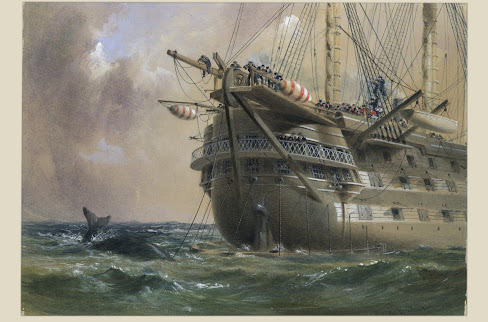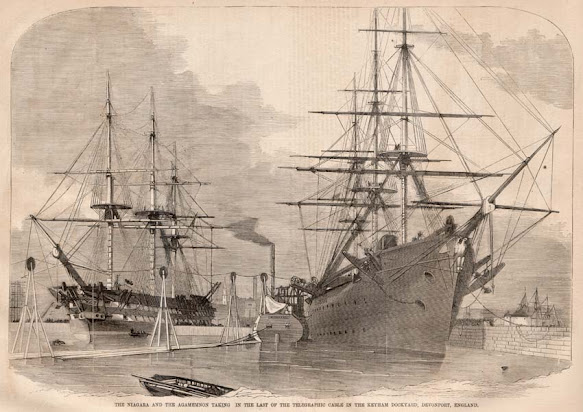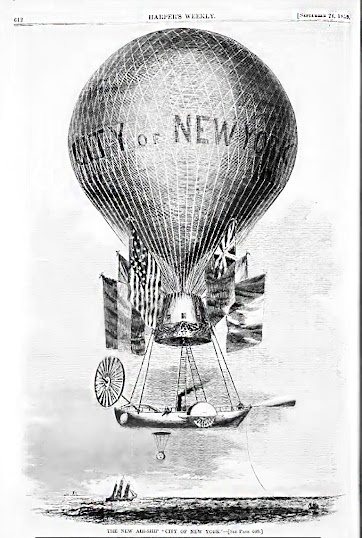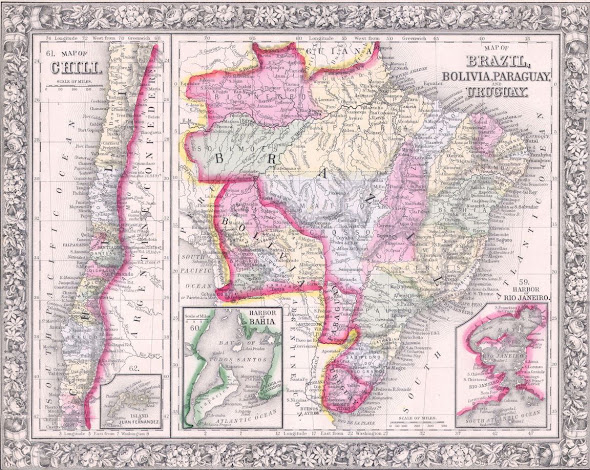Moonshot--1857 The Trans Atlantic Telegraph
Early experiments in laying telegraph cable underwater demonstrated it took a lot more redesigning than simply putting more gutta percha and tar insulation around the copper wires and plunking it in the water.
Experiments using different numbers of wires wrapped together in a variety of patterns were tried. Where do you find a cable or rope maker willing to undertake making something so experimental? Once it's made, how to get 25 or 30 miles of tar coated cables transported and then smoothly unwind it into the water?
Cables between Britain and Europe lay in shallow water compared to the North Atlantic. If great storms did not stir up sand to abrade the cable's insulation and cause a short circuit, cables could be damaged or broken by ships' anchors, and fishing trawlers.
Plans to lay a line across the Atlantic faced deep skepticism. It would certainly require millions of dollars and enormous ships to lay a cable thousands of miles long into water of unknown depth.
Only a very, very rich and very, very persistent person would attempt such a thing.
Fortunately, there was one.
By age 33 in 1853, Cyrus W. Field was a rich man. His reputation was golden among New York's financiers. Surprisingly, he had done it honestly. In 1843 Field's brother had been one of the first to set up a manufacturing facility to make large rolls of cheap wood pulp based paper just as the first high speed printing presses came into use. Not only was there demand from the newspaper industry, but publishers could now print thousands of cheap "dime novels" on this paper.
Cyrus learned the paper business and went into business with two older partners. The business failed and it was discovered his partners had arranged to make Cyrus responsible for all the debt. Rather than declare bankruptcy, Field worked for years to repay every creditor not only the original amount of money owed, but interest at seven percent per annum on top of that.
After that, Field never had a problem raising capital.
By 1854 Field was looking round for a new challenge when one came to him. Frederick Gisborne, an English engineer, had recently completed setting up a telegraph network in Newfoundland. Gisborne then set out to lay underwater cables short distances from Newfoundland to Nova Scotia. The technical problems were great and Gisborne went broke. Everything he owned was seized by disappointed creditors.
But laying those cables gained Gisborne an enormous amount of technical experience convincing him a trans Atlantic cable was possible. Determined to pay his debts, Gisborne went to one man he was sure would understand him--Cyrus W. Field.
Field listened patiently and decided Gisborne was right. A corporation was formed and the entity, backed by Field, went about gaining permits and concessions from Newfoundland, Nova Scotia and the US to finish connecting Newfoundland to New York City.
New York's smart money said it was folly. How could anybody make money sending messages back and forth from a bunch of lumberjacks and cod fishermen?
None, of course. Getting a telegraph line to Newfoundland was just the start. The shortest distance to the Irish coast was from the tip of Newfoundland. By the time all the permits were in place, there was another crucial piece of information available.
The ocean's depth beyond a hundred miles or so from the shore was mostly unknown. The existence of strong deep water currents, "deep ocean rivers," was unknown and unsuspected. When lines were thrown out to take soundings, the ends were swept up in the underwater currents and dragged for miles before ever touching bottom---if they touched bottom at all.
Using a new device invented by one of his friends, US Navy Lieutenant Matthew Maury was able to obtain measurements and samples from the ocean floor at depths far greater than before. In 1854, Maury, completed a detailed map of the ocean bed between Newfoundland and Ireland, following the route most shipping followed. An underwater ridge between Newfoundland and Ireland was discovered. At no point was the depth more than two and a half miles. Moreover, there were no rough spots.
Samples taken of the ocean floor yielded only a strange, very fine sand.
The sand was sent to a leading "microscopist," Dr. Bailey at the US Military Academy at West Point. What Bailey found would have a huge impact on both modern day oceanography and modern ecology.
There was not a grain of sand in any of the samples.
The "sand' was actually the skeletons and remains of billions of plankton, krill and other microscopic creatures. It was the first time scientists had ever considered what was truly at the bottom of the food chain supporting the rest of the ocean ecology.
May 18, 1857 London News
On Saturday the United States steamship, the Niagara, dropped down the river to the moorings at East Greenwich and today her Majesty’s ship Agamemnon 91 guns, will come round from Portsmouth and take up her moorings there to ship the submarine telegraph to be laid down in the Atlantic Ocean to connect the continents America and Europe. The length of the cable to be put on each vessels exceeds 1,300 miles; it will take upward of six weeks to deposit the cable in the ships’ holds. According to present arrangements her Majesty’s ship Agamemnon and the United States steam frigate Niagara will leave the Thames about the first week in July in company with her Majesty’s ship Cyclops and will proceed to the latitude midway between the west coast of Ireland and Newfoundland. Here the ends of the cable on each ship will be joined; the Agamemnon will then return towards the coast of Ireland and the Niagara will hold her course to the shores of Newfoundland, both ships paying out the cable as they increase the distance between them and maintaining constant telegraphic contact with each other to prove that the cable remains intact, and in six days after the ship separate, should no accident occur, telegraphic communication will open between the two continents.
May 16, 1857 From the Liverpool Albion
The United States frigate, Niagara, which was expected to arrive in the Mersey, has, it is supposed, through some mistake proceeded to the Thames, and there is now some doubt whether on survey whether she is suited for the contemplated service of assisting in laying down the Atlantic telegraph cable. She has a full complement of officers and a crew of 500 men. The Agamemnon is on the contrary fitted as a storeship and is placed under the command of the most experienced masters in the navy with only a sufficient dockyard crew for the special service required. Unless the captain of the Niagara has discretionary power to reduce the number of officers and crew and make the necessary alterations for the reception and laying out of the cable, the company will probably not be able to avail themselves of her services; but no doubt is entertained of the United States government giving the company an equivalent amount of money for the hire of a suitable vessel.
Cross section of the USS Niagara Showing where the cable was stored
Loading and carefully coiling 1,300 miles of cable into each ship so it wouldn't tangle in the machinery took six to seven weeks.
(Sometimes tech support is just no help, but things right themselves mysteriously anyway. Who knows whether the techies mentioned below found a reset button or just pressed "any key.")
Laying of the submarine telegraph
September 12, 1857 The New York Herald
Another extraordinary event in the history of this expedition has also been passed over without an attempt at explanation. It will be remembered that the day before the cable parted the continuity was interrupted for two hours and a half. During that interval the electric current refused to pass to the coast of Ireland or back to the (ship) Niagara. The scientific men on board took counsel and decided the gutta percha had worn off a portion of the wire, and that the insulation was hopelessly destroyed. It was actually agreed upon to cut the cable and return to England, when suddenly, as if by magic, the continuity was restored, and messages began to flash along the wire. Among the wise heads which surrounded the machine that day are none who can account for this phenomenon? If submarine line is subject to such eccentricities as this, its value will be materially decreased.
The Atlantic Telegraph
Harper’s Weekly June 1858
The experiments which have been made with the new telegraph machines of Professor Hughes upon the Atlantic cable have been quite successful. The instruments transmitted messages through the whole length of the cable, and clearly demonstrated that they would work with more rapidity and with greater reliability than any other method. Mr. Cyrus W. Field called on the 13th ultimate upon Sir John Packington, the First Lord of the Admiralty, and explained to him the situation of the Atlantic Telegraph Company, in regard to the paddlewheel steamer to act as tender upon the Niagara in place of the Susquehanna, which the United States Government were prevented from sending on account of the yellow fever having broken out on board of her. The Admiralty at once granted the request to furnish a steamer in place of the Susquehanna. The liberality of the British Government in placing four of their best steamers at the disposal of the Atlantic Telegraph Company to assist in laying the cable this year, and at a time when they are chartering merchant steamers for their own service, shows the deep interest they feel in the success of this great international enterprise.
Within five miles the cable broke.
Reconnected, the ships proceeded about 60 miles when cable broke again. A third try broke after 200 miles of cable had been laid.
The ships returned to Europe.
The company directors were inclined to give up now and write the whole attempt off. With difficulty, Field persuaded the group to make one more attempt before the summer weather faded.
One more chance and that was it, the directors replied.
The ships set out one last time, meeting in mid ocean on July 29, 1858. Seven days later, August 5, 1858, the cable was successfully laid and attached to telegraph stations at Valentia, Ireland and Trinity Bay, Newfoundland.
Testing the cable took about two weeks and just before the press started to raise suspicions the cable didn't work, Queen Victoria sent the first official telegram, a 98 word message of congratulations and hope for a peaceful future, to President James Buchanan on August 16, 1858.
The public on both sides of the Atlantic went wild. One hundred gun salutes, parades, speeches, honors and banquets for Field and the others involved followed.
Louis Comfort Tiffany bought two miles of extra cable, had it cut into 4 inch long (10 cm) pieces and packaged with a brass ring and a certificate of authenticity. The New York police had to be called in to control the crowds gathered at his store to buy the mementos.
A Brooklyn newspaper editor pointed out that Tiffany had bought enough cable to provide over four million American families with a 4 inch souvenir and that at the rate Tiffany was charging the the value of his cable was on the order of twelve times more than the capitalization of Field's telegraph company itself.
"Two weeks cut to two minutes," was the slogan of the day, comparing the average time a steamship needed to cross the ocean to the speed of telegraph messages.
The public did not know it took sixteen hours to send the Queen's message and nineteen hours to confirm. Even then, some back stage slight of hand was needed to interpret the signals.
The speed and quality of messages deteriorated quickly. By the second week in September 1858, the cable failed and could not be revived.
Public outrage equaled the public's exhilaration the month before. Like people claiming the NASA moon landing was a hoax, people began saying the cable had never worked and the messages were all fake. Men's reputations were ruined and Tiffany was stuck with thousands of worthless four inch lengths of cable.
Six years later, in 1864, Field tried and failed to raise capital for another attempt to lay cable while the United States was distracted by both the Civil War and the 1864 presidential campaign.
In July 1865, Field crossed the Atlantic for London--one of 60 trips back and forth he made from 1855 through 1866--to try once again.
Newspapers universally made fun of his ambition now. Everybody predicted failure. How many times did he have to fail and how much money did he have to lose before admitting a trans Atlantic telegraph cable was a physical impossibility?
The next blog entry will be on how Cyrus Field finally succeeded.



















Comments
Post a Comment